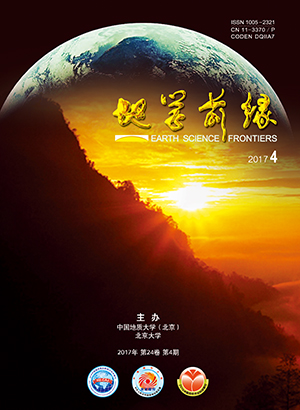|
|
Tectonic deformation sequences of sedimentary basins: Ⅰ. Associations of tectonic deformation in late Paleozoic pull-apart basin and Au-Cu-Pb-Zn-polymetallic ore-concentrated areas in the Qinling Orogenic Belt
FANG Weixuan,HUANG Zhuanying
2019, 26(5):
53-83.
DOI: 10.13745/j.esf.sf.2019.8.13
Researches on tectonic deformation sequences, tectonic styles and tectonic associations for late Paleozoic pull-apart basins, and their relationships with the Carlin-type or Carlin-like gold deposits and SEDEX-type Ag-Cu-Pb-Zn-barite-siderite deposits in the Qinling Orogenic Belt, are very useful in obtaining a better understanding of the metal ore-concentrated areas and factors controlling large-scale mineralization. The Zhashan and Fengtai late Paleozoic pull-apart basins are two ore-concentrated areas for Carlin-type or Carlin-like gold deposits and SEDEX-type Ag-Cu-Pb-Zn-barite-siderite deposits. In this report, using a new method of tectonic lithofacies, we studied the tectonic deformation sequences, tectonic styles, tectonic associations and pattern-phase of deformation tectonics for the Zhashan and Fengtai late Paleozoic pull-apart basins in the Qinling Orogenic Belt, and relationships among reworking and superimposing mineralization of Au-Ag-Cu-Pb-Zn deposits. Tectonic deformation sequences and deformation tectonic associations for late Paleozoic pull-apart basins on the northern margin of the Qinling micro-block may be classified into four stages as follows: (1) tectonic-thermal event and tectonic associations, including CP tectonic-heating event, events of layering shear rheology tectonics and zone of alkaline hydrothermal brecciation at depth, during the basin-inversion stage from the Carboniferous period to the Middle Triassic epoch (DS1), formed by the oblique-directed subduction of continent to continent. These tectonic associations consisted of the tectonic lithofacies patterns of layering shear rheology tectonics of the Devonian strata [DS1(DS0∥S1)], Na-K-Cl-F-type percolating-replacement lithofacies of thermal-fluids [DS1ahS1∥S0+S1#S0], superimposed lithofacies of alkaline hot-fluids brecciation [DS1(FBD3j+D3x)], and tectonic systems of hypothermal fluids brecciation [DS1c(AbD3)]. All of these tectonic lithofacies and tectonic associations may be attached to the pattern-phase at the middle-deep level (20.425.97 km) of ductile shear domain. Also formed at this stage are the Mujiazhuang copper and Tongmugou lead-zinc deposits. Systems of alkaline hydrothermal fluids brecciation are represented by the Wangzhanggou and Ertaizi Au-Cu deposits in the Zhashan area, the Shuangwang and Qingyangou Au deposits in the Fengtai area. (2) During the main Indosinian orogeny, the intra-basin associations of tectonic styles and tectonic-magmatic thermal events comprised thrusting-folding zone, W-M-type multiple folds and compressed-shear faults, layer-cutting brittle-ductile shear zone and buried thermal tectonic system of magmatic intrusion (DS2). These tectonic deformation associations may be attached to the pattern-phase deformation tectonics at the middle-level depth (1117 km) of the brittle-ductile shear domain. However, syn-sedimentary faults on both sides of the Zhashan late Paleozoic pull-apart faulting basin were transformed into the south-directing thrusting-napping systems of the thick-skin-type, in addition to the Xiajiadian gold deposit being controlled by the ShanyangFengzhen and ZhenanBanyanzhen faults and thick-skin type thrusting-napping. Moreover, gold orebodies are hosted in the layer-cutting and layering brittle-ductile shear zones. On the other hand, syn-sedimentary faults on both sides of the Fengtai late Paleozoic pull-apart basin were converted into hedging thrusting-napping systems of thick-skin type. Furthermore, the BaguamiaoCaimagouSimaoling gold belt was controlled by back-thrusting and area of up-recoil-ramp fault, and coupled by buried thermal tectonic system of magmatic intrusions in the time-space-matter domains. Their gold orebodies were hosted in the layer-cutting brittle-ductile shear zone. The SEDEX-type Cu-Pb-Zn deposits more enriched by reworking were controlled by W-M-type multiple folds and compressed-shear faults, whereas SEDEX-type Ag-Cu-Pb-Zn-barite-siderite deposits more enriched by reworking were controlled by subsidiary athwart superimposed folds. (3) Associations of tectonic deformation consisted of intracontinental faulted-basin, tectonic system of magmatic intrusions, contracted metamorphosed zones, brittle faults, and joint-fracture (DS3) during the Yanshanian intracontinental orogenic stage. They were associations of brittle deformation at the upper-level (05.0 km) of the brittle deformation domain. They have high exploratory potential for porphyry Cu-Au-Ag-Mo and skarn-type Fe-Cu-Au deposits in the Zhashan area. Actually, thrusting folds, faults and folds, joints and fractures, and low-temperature brecciations including jasper brecciation, ankerite brecciation, and siderite brecciation at stages of the Indosinian to Yanshanian movements, were predominant in the Carlin-type gold ore-concentrated areas. This pattern-phase of brittle deformation may be formed at the upper-level of the brittle deformation domain. And (4) Intracontinental strike-slip faults and wide-folds may be formed during the Himalayan movement. Here, the relationships among the Au-Ag-Cu-Pb-Zn ore-concentered areas, pattern-phase of deformation tectonics and Au-Ag-Cu-Pb-Zn mineralization are proposed as follows: the Devonian system of syn-sedimentary structures consists of syn-sedimentary faults, three-order tectonic basins and cluster series of hydrothermal sedimentary lithofacies in the Zhashan and Fengtai Devonian pull-apart basins, controlled by the ShanyangFengzhen and GuanyinxiaXiushiya syn-sedimentary faults (Shanyang to Lixian lithospheric fault zone). This association of syn-sedimentary structures accounts for the SEDEX-type Ag-Cu-Pb-Zn-barite-siderite deposits. Lithofacies series of ankerite-albite to albite-ankerite breccias may be formed by cryptoexplosive brecciation of alkaline thermal-fluids during the Carboniferous to Cretaceous period. Tectonic hydrothermal breccia is composed of lithofacies series of ankerite-albite to albite-ankerite breccias by superimposed diagenesis in heterochronous interposition of alkaline hot-fluid derived from deep source. The deep structure of this Cu-Au-Ag-Ni-Co mineral system is typified by the Wanzhanggou magmatic hydrothermal veinlet-type Cu-Au-Ag-Co-Ni and Ertaizi hydrothermal breccia type Cu-Au deposits. The tectonic lithofacies at the middle part of this mineral system are illustrated by the Shuangwang hydrothermal breccia type Au deposit. Moreover, the tectonic lithofacies at the top of this mineral system are demonstrated by the Baguamiao Au deposit. We suggest that Carlin-type or Carlin-like gold deposits are localized surround or over the tops of this mineral system.
References |
Related Articles |
Metrics
|

